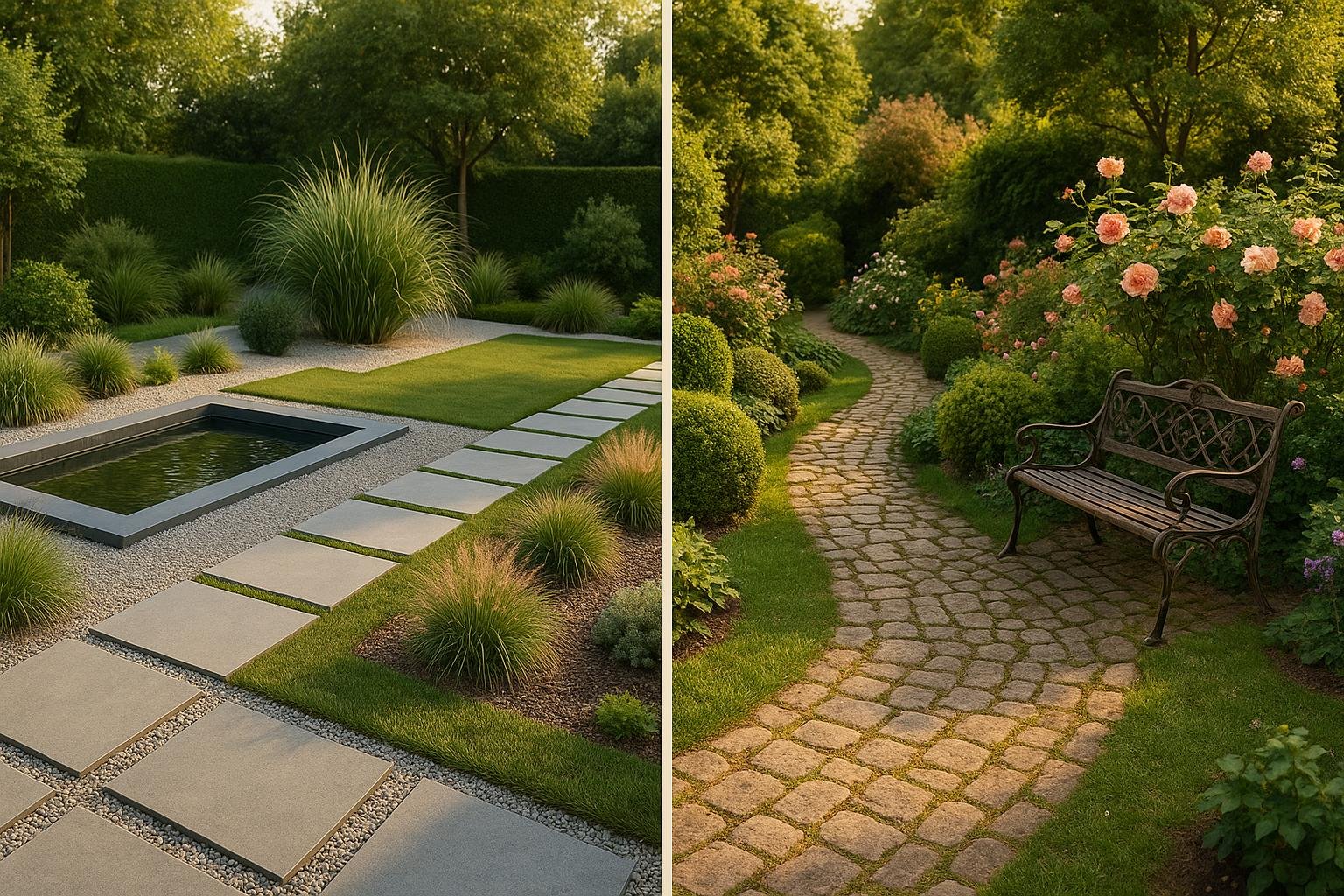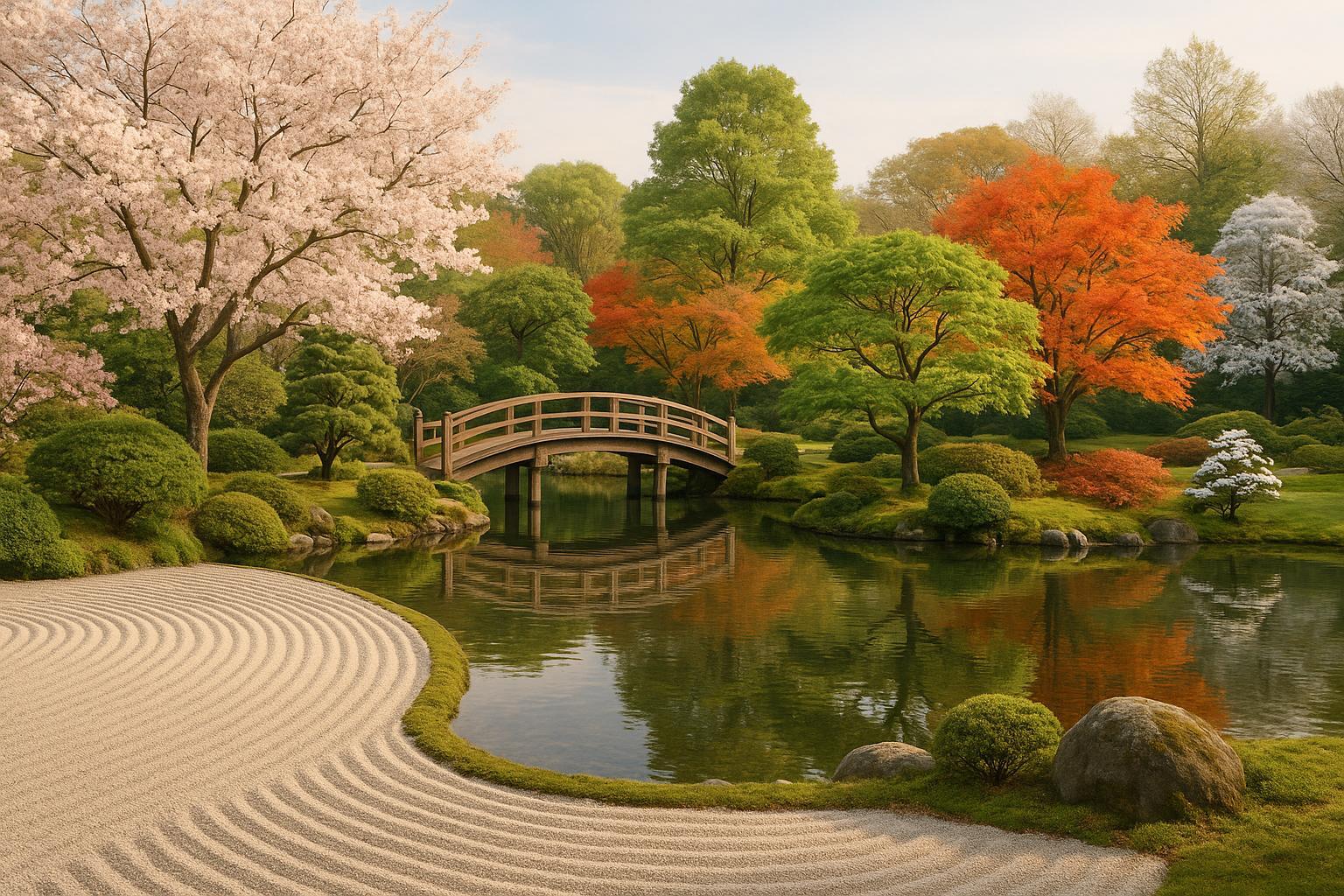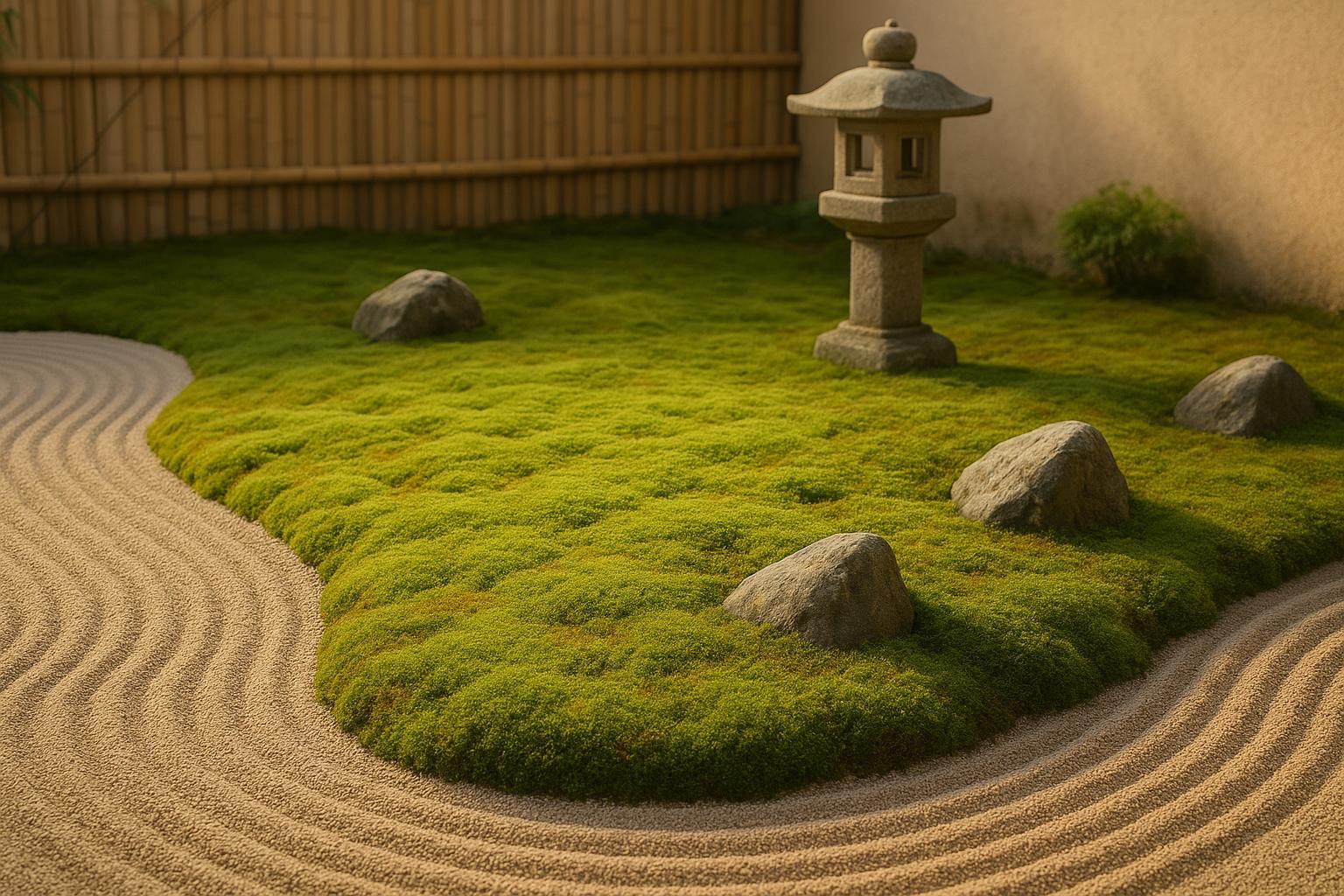Modern vs. Classic Garden Themes: AI Design Tips

Choosing between modern and classic garden styles can feel overwhelming, but AI tools simplify the process. Here's the key difference:
- Modern gardens focus on clean lines, geometric layouts, and low-maintenance plants. They use materials like concrete, steel, and glass for a sleek, minimalist look.
- Classic gardens emphasize symmetry, formal layouts, and vibrant seasonal plantings. They feature natural stone, fountains, and neatly trimmed hedges for a timeless feel.
AI tools like AIGardenPlanner let you:
- Upload a photo of your yard to get personalized modern or classic garden designs.
- Receive plant recommendations tailored to your climate and style.
- Visualize your garden in 3D before planting.
Quick Comparison
| Feature | Modern Gardens | Classic Gardens |
|---|---|---|
| Layout | Asymmetrical, open spaces | Symmetrical, formal layouts |
| Materials | Concrete, steel, glass | Stone, wood, brick |
| Plant Focus | Minimal, sculptural foliage | Vibrant flowers, trimmed hedges |
| Maintenance | Low-maintenance | Regular upkeep |
| Key Elements | Geometric shapes, industrial vibe | Fountains, statues, lush greenery |
With AI, you can even mix modern and classic elements seamlessly. For example, pair a sleek water feature with a traditional rose garden. AI tools guide you every step of the way, from design to plant care schedules.
I Let Artificial Intelligence Design My Garden Layout: Gardening Inspiration

Modern and Classic Garden Styles Explained
Understanding the differences between modern and classic garden styles can help refine your design vision.
What Makes Modern Gardens Different
Modern gardens are all about simplicity and minimalism. Landscape designer Joe Raboine from Belgard describes it perfectly:
Clean, smooth lines are the calling card of a modern design.
These gardens often feature geometric shapes and materials like concrete, steel, and glass, creating a seamless extension of a contemporary home's aesthetic. The color palette is intentionally restrained, sticking to shades of gray, black, and white. As McLeod Landscaping highlights:
Modern landscape design is all about clean lines, subtle colors, and minimalistic plants.
Instead of traditional symmetry, modern gardens embrace asymmetrical layouts. By repeating materials and using intentional asymmetry, designers create a dynamic yet balanced look.
Another hallmark of modern gardens is their low-maintenance nature. Unlike classic gardens, which often require regular care, these designs focus on structural elements rather than intricate plantings.
What Makes Classic Gardens Different
Classic gardens take a more formal approach, emphasizing symmetry and balance in their layouts. Materials like natural stone, brick, and wood are commonly used to evoke a sense of timeless elegance.
Plant selections often include neatly clipped hedges, manicured lawns, and topiaries. Decorative elements such as fountains and statues frequently serve as focal points, enhancing the garden's formal atmosphere. Classic gardens also lean into vibrant seasonal plantings, with green foliage accented by white flowers to maintain a refined yet lively appearance.
These principles reflect a long history of garden design rooted in tradition and formality.
How Garden Styles Changed Over Time
The evolution of garden design dates back thousands of years, with the earliest examples found in Egyptian tomb paintings from the 16th century BC. Over time, different styles emerged, each reflecting the cultural values of its era.
In the 18th century, English landscape gardens introduced a more natural and informal approach, which quickly became a dominant trend across Europe. In contrast, French formal gardens symbolized power and control, showcasing the ruler's dominance over nature. The Château de Vaux-le-Vicomte is a prime example of this philosophy. As co-owner Alexandre de Vogüé explains:
For me, the best definition [of a formal French garden] is the development of the house and garden together. One is not possible without the other, and this is wonderfully illustrated here at Vaux-le-Vicomte.
The 20th century brought modernism into garden design, emphasizing clean lines, geometric shapes, and functionality. This shift mirrored broader cultural changes, prioritizing individual expression over status symbols. Today, sustainability plays a key role, influencing both modern and classic garden designs.
Exploring this rich history helps us appreciate how timeless principles are being adapted to meet contemporary needs, even in the age of AI-driven design tools.
Key Design Elements Compared
When comparing modern and classic garden styles, their core design elements - layout, materials, and plant selection - reveal how each approach turns design philosophy into tangible practice.
Layout and Structure Differences
Modern gardens are all about simplicity and functionality. They often feature open spaces and asymmetrical layouts, with clean, geometric designs that echo the sharp lines of contemporary architecture. On the other hand, classic gardens lean into symmetry and formality, creating a sense of balance and harmony. For example, Italian Renaissance gardens are known for their geometric divisions and straight lines, all connected by a central axis. While modern gardens use intentional asymmetry to create visual interest, classic gardens rely on structured layouts to convey timeless elegance. These design philosophies are further expressed through the materials each style employs.
Material Choices for Each Style
The materials used in modern and classic gardens distinctly reflect their design philosophies. Modern gardens embrace an industrial vibe, incorporating materials like concrete, steel, and glass. For instance, geometric precast concrete stepping stones are a popular choice for pathways due to their versatility and affordability. Classic gardens, by contrast, highlight natural beauty, using stone and wood for pathways, furniture, and decorative accents. Elements like white or stone columns can double as freestanding art pieces or structural supports for arbors and pergolas.
| Element | Modern Gardens | Classic Gardens |
|---|---|---|
| Furniture | Metal, glass, plastic, or synthetic rattan with clean lines | Wood, wrought iron, or wicker rattan with intricate details |
| Decorative Elements | Architectural sculptures or planters made from concrete, resin, or ceramic in gray or bold colors | Classical statues or fountains |
| Hardscaping | Geometric shapes and clean lines | Elegant curves and arches |
Even the color palettes differ. Modern gardens tend to stick with subtle, muted tones, while classic gardens often feature brighter, more varied colors to enhance their visual appeal.
Plant Choices and Color Schemes
Plant selection plays a key role in defining the character of a garden, and it's here that the contrast between modern and classic styles becomes most apparent. Modern gardens focus on structure and sculptural qualities, treating plants like pieces of abstract art. Instead of prioritizing decorative blooms, they emphasize foliage for its shape, texture, and balance. Christopher Tunnard, a noted landscape architect, summed up this approach well:
To plant is but a part of landscape composition; to co-ordinate is all.
Modern gardens often feature a limited, repetitive selection of plants to create a cohesive look. Favorites include Yucca varieties like "Color Guard" and "Bright Edge", the Canna Toucan® series, and standout Hosta varieties such as Shadowland® "Autumn Frost" and "Paul's Glory". Bold focal points are created with architectural plants like New Zealand Flax "Sundowner" and striking succulents like Aeonium "Zwartkop".
Classic gardens, on the other hand, embrace vibrant, colorful plantings. They often use mixed borders and complementary color schemes - think red and green, orange and blue, or purple and yellow - to create a lively, harmonious effect. White gardens, with their understated elegance, remain a perennial favorite.
Patricia Fox from Aralia Garden Design captures the modern approach to color beautifully:
One of the things I love about using color in contemporary gardens is that there are no rules...There's a real sense of freedom, which can lead to a truly innovative garden space.
Modern gardens often reflect this philosophy by using restraint. Designers might choose a single flower or color to serve as an accent, creating dramatic impact through simplicity rather than abundance.
🚀 Ready to Reinvent Your Garden?
Join thousands of homeowners who have transformed their gardens using our AI design tool. Upload one photo to explore endless possibilities.
Get your AI garden designs →How AI Improves Garden Theme Design
Artificial intelligence is changing the way we approach garden design, making it easier than ever to create beautiful modern or classic gardens. By analyzing your garden's specific features and your personal style preferences, AI-powered tools can provide tailored design plans - something that once required hiring a professional landscape designer.
AI Style Matching
With tools like AIGardenPlanner, choosing between modern and classic garden themes becomes a breeze. Simply upload a photo of your garden, and the AI will assess factors like layout, soil type, sunlight exposure, and existing features. Based on this analysis, it suggests designs that align with your vision - whether you prefer the sleek, structured look of a modern garden or the timeless charm of a classic one. These personalized recommendations also set the stage for precise plant suggestions that fit both your style and your garden’s conditions.
Custom Plant Suggestions
One of the standout benefits of AI in garden design is its ability to recommend plants that not only complement your chosen theme but also thrive in your specific environment. AIGardenPlanner’s AI Plant Advisor matches plants to your local climate and garden conditions, creating a customized plan. It even provides detailed care instructions, seasonal planting schedules, and helpful tips to ensure your garden flourishes year-round.
3D Views and Professional Designs
AIGardenPlanner also offers advanced visualization tools, including immersive 3D views that let you preview your garden design before you start planting. These high-quality, professional-grade visuals allow homeowners and landscapers to see precise plant placements and how the garden will evolve with the seasons. This feature simplifies the design process and ensures every detail is executed with care.
sbb-itb-4d6a8dd
Common Garden Design Problems AI Can Fix
Designing a garden comes with its fair share of challenges, from making the most of small spaces to choosing plants that thrive in specific climates. AI-powered tools are changing the game by offering smart, data-backed solutions for both modern and traditional garden designs.
Making Small Spaces Work Better
Small gardens can be tricky to design - there's often limited room to work with, and traditional methods might involve a lot of trial and error. AI tools, however, streamline the process by analyzing environmental factors and providing precise recommendations, cutting down on planning time significantly.
For modern garden styles, AI can help you maximize your space by analyzing dimensions and sunlight exposure. It offers layout suggestions that create a sense of depth without making the area feel cramped. If you're leaning toward a classic style, AI can design layouts that maintain a formal and timeless look, even in tight spaces. Plus, well-optimized layouts can boost plant productivity by up to 40%, making every square foot count.
Tools like AIGardenPlanner even let you visualize your garden in 3D, so you can see how it will look across different seasons. This feature ensures your garden remains functional and beautiful all year long.
Matching Plants to Climate and Care Needs
Choosing the right plants for your garden can be overwhelming, especially when factoring in climate, soil type, and weather patterns. AI simplifies this process by analyzing local conditions and suggesting plants that are most likely to thrive.
For modern gardens, where water conservation and clean lines are often priorities, AI can recommend drought-tolerant plants or species that align with a minimalist aesthetic. If you're designing a classic garden, the technology can help you select plants that match traditional themes while keeping maintenance manageable. This tailored approach ensures your garden not only looks great but also aligns with your gardening goals.
AIGardenPlanner's AI Plant Advisor is particularly helpful. It offers plant recommendations based on your location, climate, and preferences, along with detailed growing guides to help you succeed.
Creating Care Schedules
Even the best-designed gardens need regular upkeep, and this is where AI shines. It creates personalized care schedules tailored to your plants, local weather, and seasonal needs, taking the guesswork out of maintenance.
By analyzing your garden's specifics, AI can generate detailed calendars for tasks like pruning, watering, and fertilizing. For modern gardens, this might mean reminders to keep everything looking sleek and tidy. For classic gardens, it ensures seasonal tasks are handled on time to preserve their charm.
AIGardenPlanner not only saves you time - up to 4 hours per design - but also ensures your garden gets the care it needs to thrive. The AI Plant Advisor provides expert advice based on plant species, soil type, and sunlight exposure, helping you maintain a flourishing garden with ease.
Mixing Modern and Classic Styles with AI
AI-powered visual tools make it easier than ever to blend modern and classic garden styles without relying on guesswork. These tools streamline the design process, allowing you to experiment and refine ideas with confidence.
Combined Design Methods
AI takes earlier matching techniques to the next level by harmonizing modern simplicity with classic elegance. It does this by simulating how these styles interact visually. For instance, AI can help you envision a fusion of traditional and contemporary elements - like pairing a timeless rose garden with sleek, modern water features. Instead of wondering whether these elements will work together, you can see a realistic preview of the final look.
Platforms like AIGardenPlanner make this process even more user-friendly. With access to over 50 garden styles, you can explore combinations such as formal layouts enhanced with modern materials like concrete or steel. These tools also integrate regional plant data and growth patterns, ensuring that your design is not only beautiful but also practical.
The real magic of AI is in its flexibility. These visualizations act as a starting point, not rigid plans. You can adapt the suggestions to fit your personal aesthetic while staying true to core design principles. For example, you could start with a classic English garden framework and add drought-resistant plants or modern lighting to create a style uniquely yours. AI also helps by combining visual design with local plant knowledge, offering tailored advice to ensure your garden thrives in your specific climate.
Future Trends in AI Garden Design
AI isn’t just about merging styles; it’s also shaping the future of garden aesthetics. One rising trend is the modern–classic fusion, which blends traditional gardening practices with contemporary design elements. This reflects a growing interest in honoring timeless gardening traditions while embracing modern efficiency and sustainable practices. Future advancements in AI are expected to focus on integrating eco-friendly solutions with aesthetic goals, such as predicting seasonal changes and creating maintenance schedules for complex designs.
Thanks to developments in machine learning and image recognition, AI tools are becoming smarter and more intuitive. Imagine uploading a photo of a garden element you admire - like a rustic pergola or minimalist stone path - and having AI suggest ways to incorporate similar features into your own space. Whether you’re designing a cozy cottage garden or a sleek modern landscape, AI turns traditional design challenges into innovative, personalized solutions.
Conclusion: Making Garden Design Easier with AI
Choosing between modern and classic garden themes doesn’t have to feel daunting anymore. Thanks to AI-powered design tools, homeowners and landscapers can now visualize, customize, and refine outdoor spaces before a single seed is planted. This shift has simplified the entire process, making garden planning more accurate and efficient.
Whether you’re drawn to sleek, modern layouts or the timeless charm of traditional designs, AI tools eliminate the need for manual sketches by offering precise, data-backed insights that remove much of the uncertainty from the design process.
If you’re looking to mix and match styles, AI also makes it simple to combine modern and classic elements seamlessly. With tools like AIGardenPlanner, you can experiment with creative fusion designs that reflect your unique preferences while staying true to established design principles.
But it doesn’t stop at the design phase. AI continues to support your garden’s health with features like automated irrigation schedules and maintenance plans. These tools analyze the specific needs of each plant to optimize water use and promote steady growth. This proactive approach ensures that your garden not only looks great but thrives over time.
🎨 Visualize Your Dream Garden Today!
Transform any outdoor space into a professional landscape design in minutes. Just upload a photo, choose your style, and let our AI do the rest.
Start your garden transformation now →FAQs
How can AI tools like AIGardenPlanner help me choose between modern and classic garden styles?
AI-powered tools like AIGardenPlanner simplify the process of choosing between modern and classic garden styles by offering customized design suggestions that match your preferences and surroundings. Just upload a photo of your yard, and the AI evaluates it to recommend styles that complement your space - whether you lean toward the sleek, clean lines of modern gardens or the enduring charm of classic designs.
Beyond design inspiration, the platform also delivers tailored plant recommendations based on your local climate, soil type, and personal style. This ensures your garden isn’t just visually appealing but also well-suited to thrive in your environment. With AI’s ability to simulate various layouts and styles, you can explore a range of possibilities and confidently create a garden that feels just right for your home.
What are the main differences in plant choices for modern vs. classic garden designs, and how can AI help make the best selections?
The choice of plants is a key distinction between classic and modern garden designs, reflecting each style's unique character and purpose. Classic gardens lean towards symmetry and tradition, featuring plants like roses, boxwoods, and ornamental shrubs to evoke a formal, timeless elegance. In contrast, modern gardens emphasize simplicity and practicality, often showcasing native plants, drought-resistant species, and low-maintenance greenery that align with clean, minimalist aesthetics.
AI takes the guesswork out of plant selection by analyzing essential factors such as soil type, climate, and sunlight specific to your location. These tools offer tailored plant recommendations that not only suit your design preferences but also thrive in your environment. Plus, with AI-driven visualization, you can experiment with different plant arrangements, making it easier to create a garden that seamlessly blends beauty with functionality.
How does AI help create a modern-classic garden that thrives in my local climate?
AI taps into cutting-edge tools to assess your local climate, soil type, and other environmental factors. Using this information, it suggests plants that are perfectly suited to your area, giving them the best chance to flourish. It even fine-tunes garden layouts to maximize sunlight exposure and improve water efficiency, while creating irrigation schedules that align with your local weather patterns.
This tailored approach doesn’t just boost plant health and longevity - it also helps conserve resources by cutting down on water waste. With AI, you can design a gorgeous, resilient garden that blends style with practicality.
Related posts
Related Articles

How AI Matches Plants to Your Garden Style
AI tools revolutionize garden planning by providing personalized plant recommendations based on your garden style, climate, and preferences.

AI in Drone Gardening Analytics
Explore how AI-powered drones are revolutionizing gardening with precise analytics, resource optimization, and sustainable practices for better plant health.

How to Design a Seasonal Japanese Garden
Learn how to design a seasonal Japanese garden that evolves with nature, focusing on harmony, balance, and the beauty of each season.

5 Botanical Garden Outfit Ideas for a Stylish and Comfortable Visit
Discover the best botanical garden outfit ideas to stay stylish and comfortable during your visit. Explore comfortable footwear options, accessories to enhance your look, weather-appropriate clothing choices, and tips on incorporating floral patterns and colors.

Ultimate Guide to Moss Cultivation for Zen Gardens
Learn how to cultivate moss for Zen gardens, ensuring a tranquil atmosphere with minimal maintenance and tailored care techniques.

AI Tools for Holiday Garden Planning
Transform your garden into a festive holiday display effortlessly with AI tools that personalize designs and plant recommendations.